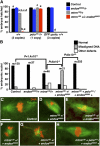A Genetic Screen for Dominant Enhancers of the Cell-Cycle Regulator α-Endosulfine Identifies Matrimony as a Strong Functional Interactor in Drosophila
- PMID: 22384372
- PMCID: PMC3276179
- DOI: 10.1534/g3.111.001438
A Genetic Screen for Dominant Enhancers of the Cell-Cycle Regulator α-Endosulfine Identifies Matrimony as a Strong Functional Interactor in Drosophila
Abstract
The coordination of cell-cycle events with developmental processes is essential for the reproductive success of organisms. In Drosophila melanogaster, meiosis is tightly coupled to oocyte development, and early embryos undergo specialized S-M mitoses that are supported by maternal products. We previously showed that the small phosphoprotein α-endosulfine (Endos) is required for normal oocyte meiotic maturation and early embryonic mitoses in Drosophila. In this study, we performed a genetic screen for dominant enhancers of endos(00003) and identified several genomic regions that, when deleted, lead to impaired fertility of endos(00003)/+ heterozygous females. We uncovered matrimony (mtrm), which encodes a Polo kinase inhibitor, as a strong dominant enhancer of endos. mtrm(126) +/+ endos(00003) females are sterile because of defects in early embryonic mitoses, and this phenotype is reverted by removal of one copy of polo. These results provide compelling genetic evidence that excessive Polo activity underlies the strong functional interaction between endos(00003) and mtrm(126). Moreover, we show that endos is required for the increased expression of Mtrm in mature oocytes, which is presumably loaded into early embryos. These data are consistent with the model that maternal endos antagonizes Polo function in the early embryo to ensure normal mitoses through its effects on Mtrm expression during late oogenesis. Finally, we also identified genomic deletions that lead to loss of viability of endos(00003)/+ heterozygotes, consistent with recently published studies showing that endos is required zygotically to regulate the cell cycle during development.
Keywords: Drosophila; early embryonic cell cycle; matrimony; polo; α-endosulfine.
Figures





Similar articles
-
Functional Consequences of the Evolution of Matrimony, a Meiosis-Specific Inhibitor of Polo Kinase.Mol Biol Evol. 2019 Jan 1;36(1):69-83. doi: 10.1093/molbev/msy197. Mol Biol Evol. 2019. PMID: 30351378 Free PMC article.
-
Binding of Drosophila Polo kinase to its regulator Matrimony is noncanonical and involves two separate functional domains.Proc Natl Acad Sci U S A. 2013 Mar 26;110(13):E1222-31. doi: 10.1073/pnas.1301690110. Epub 2013 Mar 11. Proc Natl Acad Sci U S A. 2013. PMID: 23479640 Free PMC article.
-
alpha-Endosulfine is a conserved protein required for oocyte meiotic maturation in Drosophila.Development. 2008 Nov;135(22):3697-706. doi: 10.1242/dev.025114. Epub 2008 Oct 16. Development. 2008. PMID: 18927152 Free PMC article.
-
The centrosome in Drosophila oocyte development.Curr Top Dev Biol. 2000;49:385-407. doi: 10.1016/s0070-2153(99)49019-2. Curr Top Dev Biol. 2000. PMID: 11005029 Review.
-
Developmental control of oocyte maturation and egg activation in metazoan models.Cold Spring Harb Perspect Biol. 2011 Oct 1;3(10):a005553. doi: 10.1101/cshperspect.a005553. Cold Spring Harb Perspect Biol. 2011. PMID: 21709181 Free PMC article. Review.
Cited by
-
Proteome labeling and protein identification in specific tissues and at specific developmental stages in an animal.Nat Biotechnol. 2014 May;32(5):465-72. doi: 10.1038/nbt.2860. Epub 2014 Apr 13. Nat Biotechnol. 2014. PMID: 24727715 Free PMC article.
-
The mitochondrial outer membrane protein MDI promotes local protein synthesis and mtDNA replication.EMBO J. 2016 May 17;35(10):1045-57. doi: 10.15252/embj.201592994. Epub 2016 Apr 6. EMBO J. 2016. PMID: 27053724 Free PMC article.
-
A meiosis-specific form of the APC/C promotes the oocyte-to-embryo transition by decreasing levels of the Polo kinase inhibitor matrimony.PLoS Biol. 2013 Sep;11(9):e1001648. doi: 10.1371/journal.pbio.1001648. Epub 2013 Sep 3. PLoS Biol. 2013. PMID: 24019759 Free PMC article.
-
The overlooked greatwall: a new perspective on mitotic control.Open Biol. 2012 Mar;2(3):120023. doi: 10.1098/rsob.120023. Open Biol. 2012. PMID: 22754657 Free PMC article. Review.
-
Female Meiosis: Synapsis, Recombination, and Segregation in Drosophila melanogaster.Genetics. 2018 Mar;208(3):875-908. doi: 10.1534/genetics.117.300081. Genetics. 2018. PMID: 29487146 Free PMC article. Review.
References
-
- Drummond-Barbosa D., Spradling A. C., 2004. Alpha-endosulfine, a potential regulator of insulin secretion, is required for adult tissue growth control in Drosphila. Dev. Biol. 266: 310–321 - PubMed
-
- Gharbi-Ayachi A., Labbe J. C., Burgess A., Vigneron S., Strub J. M., et al. , 2010. The substrate of Greatwall kinase, Arpp19, controls mitosis by inhibiting protein phosphatase 2A. Science 330: 1673–1677 - PubMed
Grants and funding
LinkOut - more resources
Full Text Sources
Molecular Biology Databases
